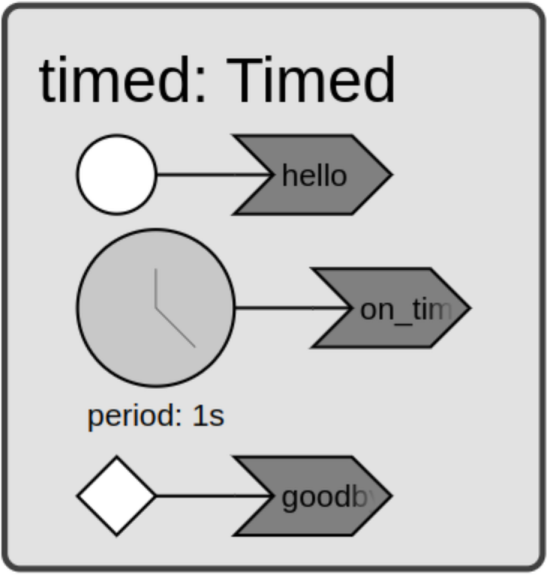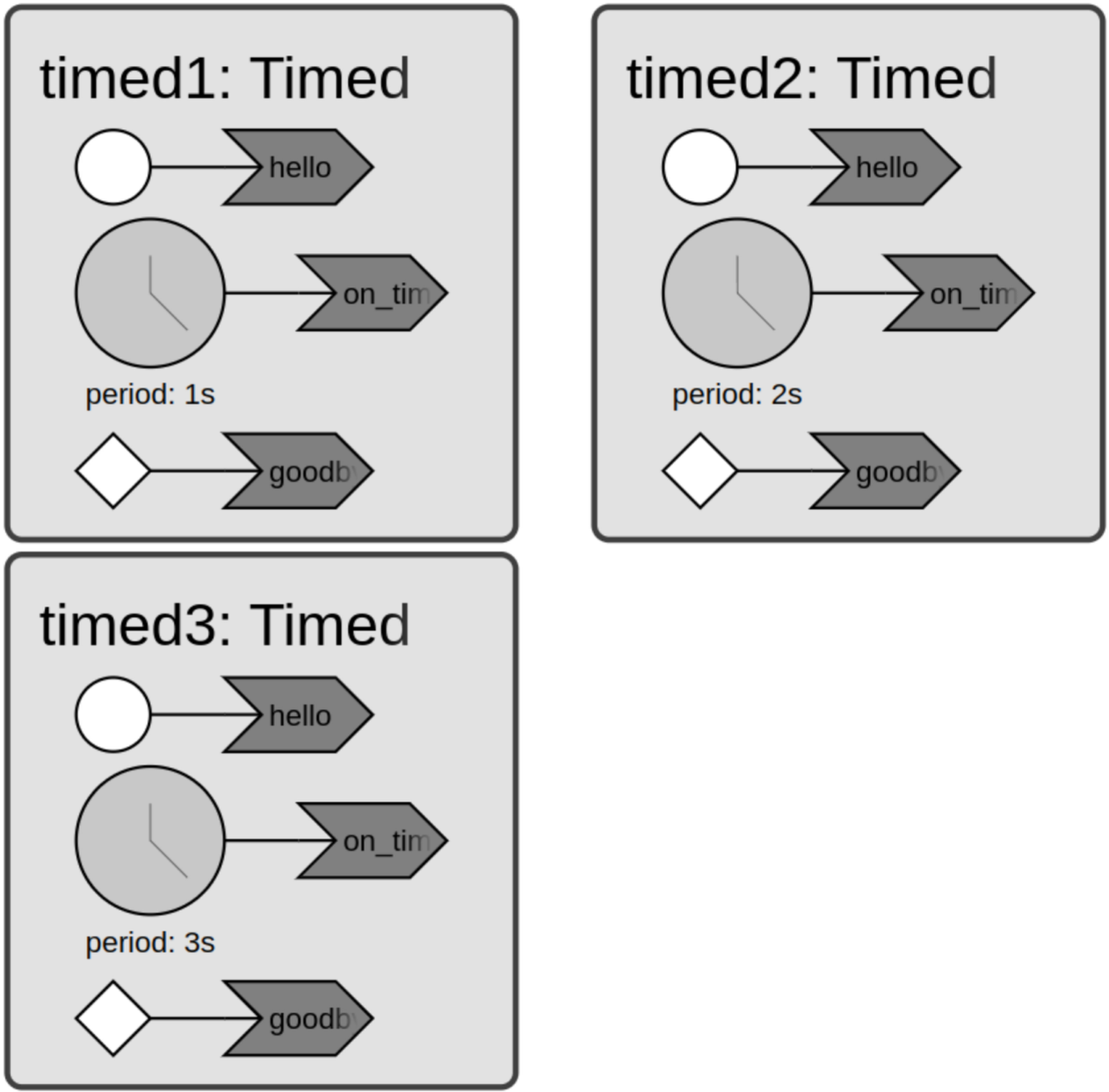Periodic Timers
The xronos framework provides powerful mechanisms for implementing timed
behavior. The simplest mechanism is provided by periodic timers. Copy the
following example into a new file called timer.py.
import datetime
import xronos
MAX_COUNT = 5
class Timed(xronos.Reactor):
_timer = xronos.PeriodicTimerDeclaration()
def __init__(self, period):
super().__init__()
self._timer.period = period
self._count = 0
@xronos.reaction
def hello(self, interface):
interface.add_trigger(self.startup)
return lambda: print(f"{self.get_time()}: {self.name} says 'Hello!'")
@xronos.reaction
def on_timer(self, interface):
interface.add_trigger(self._timer)
def handler():
self._count += 1
print(
f"{self.get_time()}: {self.name}'s timer triggered "
f"(count={self._count})"
)
if self._count == MAX_COUNT:
self.request_shutdown()
return handler
@xronos.reaction
def goodbye(self, interface):
interface.add_trigger(self.shutdown)
return lambda: print(f"{self.get_time()}: {self.name} says 'Goodbye!'")
def main():
env = xronos.Environment()
env.create_reactor("timed", Timed, period=datetime.timedelta(seconds=1))
env.execute()
if __name__ == "__main__":
main()
import datetime
from typing import Callable
import xronos
MAX_COUNT = 5
class Timed(xronos.Reactor):
_timer = xronos.PeriodicTimerDeclaration()
def __init__(self, period: datetime.timedelta) -> None:
super().__init__()
self._timer.period = period
self._count = 0
@xronos.reaction
def hello(self, interface: xronos.ReactionInterface) -> Callable[[], None]:
interface.add_trigger(self.startup)
return lambda: print(f"{self.get_time()}: {self.name} says 'Hello!'")
@xronos.reaction
def on_timer(self, interface: xronos.ReactionInterface) -> Callable[[], None]:
interface.add_trigger(self._timer)
def handler() -> None:
self._count += 1
print(
f"{self.get_time()}: {self.name}'s timer triggered "
f"(count={self._count})"
)
if self._count == MAX_COUNT:
self.request_shutdown()
return handler
@xronos.reaction
def goodbye(self, interface: xronos.ReactionInterface) -> Callable[[], None]:
interface.add_trigger(self.shutdown)
return lambda: print(f"{self.get_time()}: {self.name} says 'Goodbye!'")
def main() -> None:
env = xronos.Environment()
env.create_reactor("timed", Timed, period=datetime.timedelta(seconds=1))
env.execute()
if __name__ == "__main__":
main()
In xronos, a periodic timer can be created by instantiating
xronos.PeriodicTimerDeclaration as a class attribute. This declares a
PeriodicTimer object that is automatically initialized by the xronos
runtime. We can interact with the timer object simply by using self._timer.
Note that the __init__ method of Timed configures the timer’s period
according to an argument that it receives. It further defines the state variable
self._count and sets it to 0.
The Timed reactor defines three reactions. The hello reaction is similar to
the reaction in our “Hello, World!” example. It prints the current time, the
reactors name and ‘Hello!’. The goodbye reaction produces a similar output in
response to the builtin shutdown event.
The reaction on_timer declares the timer as its trigger and defines a reaction
handler that is a little bit more complex than the simple lambda function we
have seen so far. The reaction defines a nested handler function that it then
returns.
def handler():
self._count += 1
print(
f"{self.get_time()}: {self.name}'s timer triggered "
f"(count={self._count})"
)
if self._count == MAX_COUNT:
self.request_shutdown()
return handler
The handler performs multiple steps. First, it increments the self._count
variable. It then prints the current time, the timer’s name and
the current count. Finally, it checks if the count has reached MAX_COUNT, in
which case request_shutdown() is called to terminate
the program.
The program runs for about 4 seconds and produces output similar to the following:
$ python timer.py
2024-11-29 10:17:13.893071: timed says 'Hello!'
2024-11-29 10:17:13.893071: timed's timer triggered (count=1)
2024-11-29 10:17:14.893071: timed's timer triggered (count=2)
2024-11-29 10:17:15.893071: timed's timer triggered (count=3)
2024-11-29 10:17:16.893071: timed's timer triggered (count=4)
2024-11-29 10:17:17.893071: timed's timer triggered (count=5)
2024-11-29 10:17:17.893071: timed says 'Goodbye!'
Carefully look at the printed timestamps. The timestamp printed by hello is
identical to the first line printed by on_timer. This is, because we did not
configure an offset and the first event triggers
immediately at startup. In other words: the first timer event is simultaneous to
the startup event. Also note that the individual timer
events are perfectly spaced one second apart.
How can xronos achieve such a precision? In xronos, time behaves differently
than the wall-clock time that computer programs usually use. The xronos runtime
manages its own clock, and this clock is key to controlling how a program
executes. One property of the internal clock is that the time observed by a
reaction is equal to the timestamp of the triggering event. Moreover, any two
calls to get_time() within the same reaction handler will
return the same time value.
The synchrony of timestamps is also preserved across multiple reactors. Modify
the instantiation code as shown in the following, so that the program consists
of three Timed reactors using a period of 1 second, 2 seconds and 3 seconds,
respectively.
def main():
env = xronos.Environment()
env.create_reactor("timed1", Timed, period=datetime.timedelta(seconds=1))
env.create_reactor("timed2", Timed, period=datetime.timedelta(seconds=2))
env.create_reactor("timed3", Timed, period=datetime.timedelta(seconds=3))
env.execute()
def main():
env = xronos.Environment()
env.create_reactor("timed1", Timed, period=datetime.timedelta(seconds=1))
env.create_reactor("timed2", Timed, period=datetime.timedelta(seconds=2))
env.create_reactor("timed3", Timed, period=datetime.timedelta(seconds=3))
env.execute()
Running the program produces output similar to the following:
$ python timer.py
2024-11-29 10:48:57.423695: timed2 says 'Hello!'
2024-11-29 10:48:57.423695: timed3 says 'Hello!'
2024-11-29 10:48:57.423695: timed1 says 'Hello!'
2024-11-29 10:48:57.423695: timed2's timer triggered (count=1)
2024-11-29 10:48:57.423695: timed3's timer triggered (count=1)
2024-11-29 10:48:57.423695: timed1's timer triggered (count=1)
2024-11-29 10:48:58.423695: timed1's timer triggered (count=2)
2024-11-29 10:48:59.423695: timed2's timer triggered (count=2)
2024-11-29 10:48:59.423695: timed1's timer triggered (count=3)
2024-11-29 10:49:00.423695: timed3's timer triggered (count=2)
2024-11-29 10:49:00.423695: timed1's timer triggered (count=4)
2024-11-29 10:49:01.423695: timed2's timer triggered (count=3)
2024-11-29 10:49:01.423695: timed1's timer triggered (count=5)
2024-11-29 10:49:01.423695: timed2 says 'Goodbye!'
2024-11-29 10:49:01.423695: timed3 says 'Goodbye!'
2024-11-29 10:49:01.423695: timed1 says 'Goodbye!'
Note how all three reactors say ‘Hello!’ or ‘Goodbye!’ at the same time, and how the timestamps of individual timer events align between the reactors.

